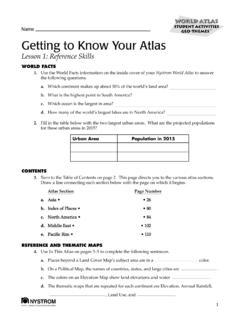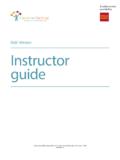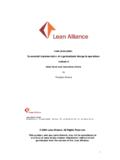Transcription of Aircraft Communications and Navigation Systems - key2study
1 Aircraft Communications and Navigation Systems : Principles, Operation and Maintenance Weather radar and ILS antennas in the nose radome of a Boeing 757 Aircraft AMSTERDAM BOSTON HEIDELBERG LONDON NEW YORK OXFORD PARIS SAN DIEGO SAN FRANCISCO SINGAPORE SYDNEY TOKYO Butterworth-Heinemann is an imprint of Elsevier Aircraft Communications and Navigation Systems : Principles, Operation and Maintenance Mike Tooley and David Wyatt Butterworth-Heinemann is an imprint of Elsevier Linacre House, Jordan Hill, Oxford OX2 8DP, UK 30 Corporate Drive, Suite 400, Burlington, MA 01803, USA First edition 2007 Copyright 2007, Mike Tooley and David Wyatt. Published by Elsevier 2007. All rights reserved The right of Mike Tooley and David Wyatt to be identified as the authors of this work has been asserted in accordance with the Copyright, Designs and Patents Act 1988 No part of this publication may be reproduced, stored in a retrieval system or transmitted in any form or by any means electronic, mechanical, photocopying, recording or otherwise without the prior written permission of the publisher.
2 Permissions may be sought directly from Elsevier's Science & Technology Rights Department in Oxford, UK: phone (+44) (0) 1865 843830; fax (+44) (0) 1865 853333; email: Alternatively you can submit your request online by visiting the Elsevier web site at , and selecting Obtaining permission to use Elsevier material Notice No responsibility is assumed by the publisher for any injury and/or damage to persons or property as a matter of products liability, negligence or otherwise, or from any use or operation of any methods, products, instructions or ideas contained in the material herein. Because of rapid advances in the medical sciences, in particular, independent verification of diagnoses and drug dosages should be made British Library Cataloguing in Publication Data A catalogue record for this book is available from the British Library Library of Congress Cataloging-in-Publication Data A catalog record for this book is available from the Library of Congress For information on all Elsevier Butterworth-Heinemann publications visit our web site at Typeset by the author ISBN.
3 978-0-7506-81377 Contents Preface Acknowledgements Online resources Chapter 1 Introduction The radio frequency spectrum Electromagnetic waves Frequency and wavelength The atmosphere Radio wave propagation The ionosphere MUF and LUF Silent zone and skip distance Multiple choice questions Chapter 2 Antennas The isotropic radiator The half-wave dipole Impedance and radiation resistance Radiated power and efficiency Antenna gain The Yagi beam antenna Directional characteristics Other practical antennas Feeders Connectors Standing wave ratio Waveguide Multiple choice questions Chapter 3 Transmitters and receivers A simple radio system Modulation and demodulation AM transmitters FM transmitters Tuned radio frequency receivers Superhet receivers Selectivity Image channel rejection Automatic gain control Double superhet receivers Digital frequency synthesis A design example Multiple choice questions xi xiv xiv 1 1 3 4 4 5 7 10 12 13 15 15 16 18 19 19 20 22 24 28 32 33 38 39 41 41 42 43 44 45 46 47 50 51 51 53 55 59 vi Contents Chapter 4 VHF Communications VHF range and propagation DSB modulation Channel spacing Depth of modulation Compression Squelch Data modes ACARS VHF radio equipment Multiple choice questions
4 Chapter 5 HF Communications HF range and propagation SSB modulation SELCAL HF data link HF radio equipment HF antennas and coupling units Multiple choice questions Chapter 6 Flight-deck audio Systems Flight interphone system Cockpit voice recorder Multiple choice questions Chapter 7 Emergency locator transmitters Types of ELT Maintenance and testing of ELT ELT mounting requirements Typical ELT Cospas Sarsat satellites Multiple choice questions Chapter 8 Aircraft Navigation The earth and Navigation Dead reckoning Position fixing Maps and charts Navigation terminology Navigation Systems development Navigation Systems summary Multiple choice questions Chapter 9 Automatic direction finder Introducing ADF ADF principles ADF equipment Operational aspects of ADF Multiple choice questions 61 61 62 63 63 64 65 65 68 70 72 73 73 74 76 76 80 81 84 85 85 90 92 93 93 94 95 97 98 100 101 101 104 105 106 107 107 114 116 117 117 117 118 122 125 Contents vii Chapter 10 VHF omnidirectional range VOR principles Airborne equipment Operational aspects of VOR Multiple choice questions Chapter 11 Distance measuring equipment Radar principles DME overview DME operation Equipment overview En route Navigation using radio Navigation
5 Aids Multiple choice questions Chapter 12 Instrument landing system ILS overview ILS ground equipment ILS airborne equipment Low range radio altimeter ILS approach Autoland Operational aspects of the ILS Multiple choice questions Chapter 13 Microwave landing system MLS overview MLS principles Aircraft equipment Ground equipment MLS summary Multiple choice questions Chapter 14 Hyperbolic radio Navigation Hyperbolic position fixing Loran overview Loran-C operation Loran-C ground equipment Loran-C airborne equipment Enhanced Loran (eLoran) Multiple choice questions Chapter 15 Doppler Navigation The Doppler effect Doppler Navigation principles Airborne equipment overview Typical Doppler installations Doppler summary Other Doppler applications Multiple choice questions 127 127 131 136 139 141 141 142 143 143 145 149 151 151 151 155 159 160 160 161 162 163 163 163 166 168 168 168 171 171 173 173 175 176 177 178 179 179 179 183 184 184 185 186 187 187 191 196 198 199 201 201 204 204 211 214 214 214 215 217 217 217 217 218 221 221 223 224 225 227 227 227 230 232 236 237 239 239 240 243 251 251 252 253 253 254 255 256 265 267 270 Chapter 16 Area Navigation RNAV overview RNAV
6 Equipment Kalman filters Required Navigation performance Multiple choice questions Chapter 17 Inertial Navigation Systems Inertial Navigation principles system overview system description Alignment process Inertial Navigation accuracy Inertial Navigation summary system integration Multiple choice questions Chapter 18 Global Navigation satellite system GPS overview Principles of wave propagation Satellite Navigation principles GPS segments GPS signals GPS operation Other GNSS The future of GNSS Multiple choice questions Chapter 19 Flight management Systems FMS overview Flight management computer system system initialisation FMCS operation FMS summary Multiple choice questions Chapter 20 Weather radar system overview Airborne equipment Precipitation and turbulence system enhancements Lightning detection Multiple choice questions Chapter 21 Air traffic control system ATC overview ATC transponder modes Airborne equipment system operation Automatic dependent surveillance-broadcast Communications .
7 Navigation and surveillance/air traffic management Multiple choice questions viii Contents Contents ix Chapter 22 Traffic alert and collision avoidance system Airborne collision avoidance Systems TCAS overview TCAS equipment system operation Multiple choice questions Appendices 1 Abbreviations and acronyms 2 Revision papers 3 Answers 4 Decibels Index 271 271 272 275 277 283 285 285 291 297 303 305 The books in this series have been designed for both independent and tutor assisted studies. They are particularly useful to the self-starter and to those wishing to update or upgrade their Aircraft maintenance licence. The series also provides a useful source of reference for those taking ab initio training programmes in EASA Part 147 and FAR 147 approved organisations as well as those following related programmes in further and higher education institutions.
8 This book is designed to cover the essential knowledge base required by certifying mechanics, technicians and engineers engaged in engineering maintenance activities on commercial Aircraft . In addition, this book should appeal to members of the armed forces and others attending training and educational establishments engaged in Aircraft maintenance and related aeronautical engineering programmes (including BTEC National and Higher National units as well as City and Guilds and NVQ courses). The book provides an introduction to the principles, operation and maintenance of Aircraft Communications and Navigation Systems . The aim has been to make the subject material accessible and presented in a form that can be readily assimilated.
9 The book provides syllabus coverage of the Communications and Navigation section of Module 13 (ATA 23/34). The book assumes a basic understanding of Aircraft flight controls as well as an appreciation of electricity and electronics (broadly equivalent to Modules 3 and 4 of the EASA Part-66 syllabus). It is important to realise that this book is not designed to replace Aircraft maintenance manuals. Nor does it attempt to provide the level of detail required by those engaged in the maintenance of specific Aircraft types. Instead it has been designed to convey the essential underpinning knowledge required by all Aircraft maintenance engineers.
10 Chapter 1 sets the scene by providing an explanation of electromagnetic wave propagation and the radio frequency spectrum. The chapter Preface also describes the various mechanisms by which radio waves propagate together with a detailed description of the behaviour of the ionosphere and its effect on radio signals. Antennas are introduced in Chapter 2. This chapter explains the principles of isotropic and directional radiating elements and introduces a number of important concepts including radiation resistance, antenna impedance, ra



